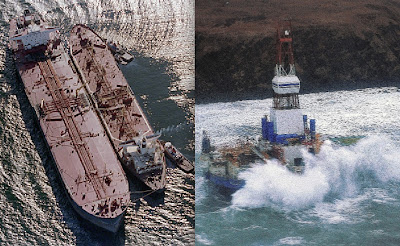First of all, there isn't much direct comparison.
The Exxon Valdez, in calm waters, left the tanker lane in Valdez Arm intentionally, and failed to change course to avoid Bligh Reef, and drove right on to it at gathering speed.
The Kulluk, after days of efforts to save it in bad midwinter seas and winds, was finally released by one of the vessels designed as a result of the Exxon Valdez disaster, by orders from an on-scene commodore, and slowly was blown onto less savage rocks.
The Exxon Valdez spewed millions of gallons of crude oil into a pristine environment, causing devastation that is lasting into the second decade of a new century. The Kulluk has yet, to our knowledge, spilled any oil.
However many less direct comparisons can be made. My first is that government agencies appear to have learned more from the Exxon Valdez oil spill (EVOS) than did oil companies.
As a result of the EVOS, the state of Alaska has deployed various oil spill response packages along our coasts. There is even a small package in Old Harbor, the community nearest to the grounding. Kodiak, Homer, Seward and especially Valdez all have packages that will be deployed at the site if needed. Shell claims it has spill mitigation assets in Seward. I can't wait to see how they compare to those possessed by the state or the USCG.
Nor will any of Shell's highly vaunted stuff they had arrayed for the farcical September-November pre-drilling in the Chukchi and Beaufort Seas be of any use in this scenario. Should the Kulluk's fuel tanks be pierced, which isn't very likely, its diesel and lubricating fuels will not be as voluminous or toxic as those of the Exxon Valdez, but there is a possibility that more than 10% of them will be contained, depending on the weather. More than 10% containment would be an achievement.
Use of dispersants (which were curtailed mostly in the EVOS because Exxon simply couldn't find enough aircraft to get it here, so they blamed environmentalists for its non-use) should be entirely avoided. We should fight any attempts to do that, should the makers of these products pressure the USCG, the state or Shell to vomit their product upon our seas and shores.
In the EVOS we saw ample evidence of oil companies shirking their responsibility to maintain an oil spill fighting capability they had convinced legislators and legacy media representatives was adequate or superior. We learned that this was a complete lie.
In the Kulluk grounding, we are seeing evidence that an oil company that had convinced lawmakers on the state and national level that they were responsible players, have been deceiving our governments, us, and perhaps the oil company itself.
The EVOS did not have an impact on oil extraction on the North Slope. It had an impact on how we are prepared for maritime disaster.
The Kulluk should be reviewed for what we can learn about backups when moving rigs in adverse seasons. But, given the promises Shell has made, and the stakes involved in their offshore drilling plans for 2013, we need to apply any lessons learned about Shell's flawed organizational structure to how we view what this means to the health of our state's offshore waters and its coasts.
Shell's 2012 season and its shortcomings need to be looked at holistically, skeptically and severely, before they are allowed back into our waters this year.

2 comments:
Phil i wish i could spell write to comment. Some times moonshine works. This grounding is an exuse. We must be more aware. Who benefits? AKjah.
Well so Phil, my first comment didn't appear, that's ok, here is my next one, see if it works, now I like everybody is prabably familiar from the FDL blogg, as I am.
I am interested in your really good coverage of the Kulluk situation, it is too interesting, as I am a maritime person to a degree... 40 years as longshoreman, dad: same grandad: same, he sailed Alaska etc. But I have worked some barges in the Bay, we had to use pretty big ropes for different stuff, and teh ropes on the ships, well, you know, 1 inch steel is only... what 20 tons... and it was 12 tons, as far as new rope on the gear for hoisting cargo... for tow operations, I wouldn't go with tiny stuff like that towing a big ponderous yawing thing like that, though to be fair, it is like a sauser shape, not like the big kluggs you usually think of as... drill rigs, with huge underwater resistance producing crap: like a hundred pluse feet deep legs.
But here is the answer that I asked you for:
http://www.mxak.org/community/kulluk/kullukmore.html
This shows the info that is key to get what it is as far as a lot of things, which in my non professional opinion will show, that: the thing won't break up on the beach, cause it is of a design that will just set down and wallow on the bottom.
The thing that go me going was the little tiney size of the rope for towing it... To me, you wouldn't use less than a 1/2 total tonnage: 200k tons unladen, =SWL safe working load, so the wire should be equal to pull 75k.
Wire chart says: I don't know, I have to close this up, but it is bigger than an inch, and take a look at the interesting positioning anchor system, where there are many huge winches capable of 3700 feet of 3.5 inch steel rope! good for the whole weight of the thing against ice flow... I guess~
Post a Comment